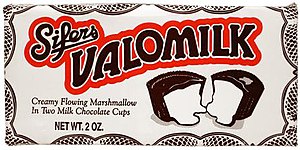

Valomilk is a marshmallow cream filled milk chocolate cup confection manufactured by the Russell Sifers Candies in Merriam, Kansas.


Valomilk is a marshmallow cream filled milk chocolate cup confection manufactured by the Russell Sifers Candies in Merriam, Kansas.
Valomilks were first created in 1931 when a candymaker at Sifers, then located in Kansas City, added too much vanilla extract to a batch of marshmallows, which never set. The semi-liquid mixture was then used for a filling in one-ounce milk-chocolate cups, the kind traditionally filled with peanut butter.
The name Valomilk represents the three ingredients: vanilla, marshmallow, and milk chocolate.
The fifth generation of the Sifers family still uses the original family recipe along with much of the original equipment. Valomilks are currently the only candy still made by the Sifers company, which discontinued its general product lines in the 1950s. [1]
In the late 1950s, Valomilk launched a promotion to celebrate the inclusion of Alaska and Hawaii into the union. Cardboard disks with the names of the capitals of all 50 states of America were placed on top of the candy cups and shipped to stores. Anyone who collected 30 of the disks could send them in to the Valomilk candy company and receive a tube of 10 free Valomilks.
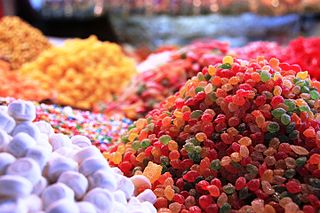
Candy, also called sweets or lollies, is a confection that features sugar as a principal ingredient. The category, called sugar confectionery, encompasses any sweet confection, including chocolate, chewing gum, and sugar candy. Vegetables, fruit, or nuts which have been glazed and coated with sugar are said to be candied.

Peeps are a marshmallow confection marketed since 1953 in the United States and Canada in the shape of chicks, bunnies, and other animals as well as holiday shapes produced by Pennsylvania-headquartered Just Born Quality Confections.

A chocolate bar or candy bar is a confection containing chocolate, which may also contain layerings or mixtures that include nuts, fruit, caramel, nougat, and wafers. A flat, easily breakable, chocolate bar is also called a tablet. In some varieties of English and food labeling standards, the term chocolate bar is reserved for bars of solid chocolate, with candy bar used for products with additional ingredients.
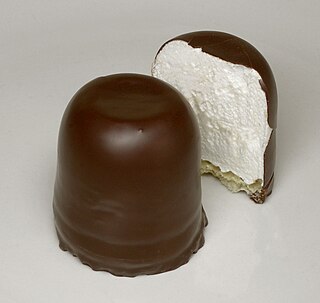
Chocolate-coated marshmallow treats, also known as chocolate teacakes, are confections consisting of a biscuit base topped with marshmallow-like filling and then coated in a hard shell of chocolate. They were invented in Denmark in the 19th century and later also produced and distributed by Viau in Montreal as early as 1901. Numerous varieties exist, with regional variations in recipes. Some variants of these confections have previously been known in many countries by names comprising equivalents of the English word negro.

Hot chocolate, also known as hot cocoa or drinking chocolate, is a heated drink consisting of shaved or melted chocolate or cocoa powder, heated milk or water, and usually a sweetener. It is often garnished with whipped cream or marshmallows. Hot chocolate made with melted chocolate is sometimes called drinking chocolate, characterized by less sweetness and a thicker consistency.

Rice Krispies is a breakfast cereal, marketed by Kellogg's in 1927 and released to the public in 1928. Rice Krispies are made of crisped rice, and expand forming very thin and hollowed out walls that are crunchy and crisp. When milk is added to the cereal the walls tend to collapse, creating the "snap, crackle and pop" sounds.
3 Musketeers is a chocolate bar made in the United States and Canada by Mars, Incorporated. It is a candy bar consisting of chocolate-covered, fluffy, whipped nougat. It is a lighter chocolate bar similar to the global Milky Way bar and similar to the American version Milky Way bar only smaller and without the caramel topping. The 3 Musketeers Bar was the third brand produced and manufactured by M&M/Mars, introduced in 1932. Originally, it had three pieces in one package, flavored chocolate, strawberry and vanilla; hence the name, which was derived from the 1844 novel The Three Musketeers by Alexandre Dumas. Rising costs and wartime restrictions on sugar saw the phasing out of the vanilla and strawberry pieces to leave only the more popular chocolate. Costing five cents when it was introduced, it was marketed as one of the largest chocolate bars available, one that could be shared by friends.
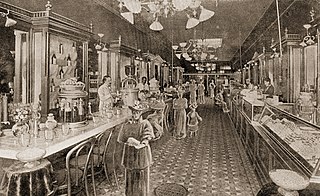
Whitman's is one of the largest and oldest brands of boxed chocolates in the United States. Whitman's confections have been produced since 1842, originally by Stephen Whitman in Philadelphia and currently by Kansas City, Missouri-based Russell Stover Candies.

Reese's Peanut Butter Cups are an American candy by The Hershey Company consisting of a peanut butter cup encased in chocolate. They were created on November 15, 1928, by H. B. Reese, a former dairy farmer and shipping foreman for Milton S. Hershey. Reese left his job with Hershey to start his own candy business. Reese's are the top-selling candy brand worldwide, with more than $2 billion in annual sales generated for The Hershey Company.

Reese's Take 5 is a candy bar that was released by The Hershey Company in December 2004. The original name of the candy bar was TAKE5 but common usage among consumers added a space. In June 2019, when the candy bar became part of the Reese's family, the name was officially changed to Reese's Take 5.
Charleston Chew is a candy bar consisting of marshmallow flavored nougat covered in chocolate flavor coating. It was created in 1925 by the Fox-Cross Candy Company, founded by stage actor Donley Cross and his friend Charlie Fox. The candy was named after the Charleston, a popular dance at that time.

Boyer Candy Company is an American candy company located in Altoona, Pennsylvania. The factory is located in the downtown district. Boyer Candy is privately owned by Consolidated Brands, which is owned by the Forgione family.

Ptasie mleczko or Bird's milk is a Central European confectionery originating in Poland. It is a small, chocolate-covered bar with a soft marshmallow-like interior.
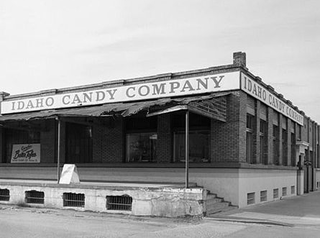
The Idaho Candy Company is a candy manufacturer in Boise, Idaho, United States. They are best known for the Idaho Spud bar, which has a cult following in the Northwestern United States. The company has been making the popular bar of marshmallow filling covered in chocolate and coconut since 1918. Though many historic candy makers have since gone out of business, in past decades, the Idaho Candy Company competed with other local producers like the Idaho Russet made by the Dainty Maid company and another "Spud Bar" from Utah made by Ostler Candy.
The following outline is provided as an overview of and topical guide to chocolate:

A sno-ball is a confection made with finely shaved ice and flavored sugar syrup. Commonly confused with the snow cone, the ice of a sno-ball is fine and fluffy; while a snow cone's ice is coarse, crunchy, and granular. Moreover, whereas in a snow cone the flavored syrup sinks to the bottom of the cup, in a sno-ball the ice absorbs the syrup.